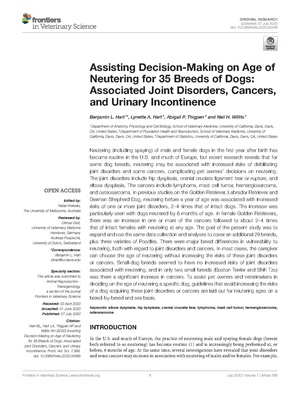Assisting Decision-Making on Age of Neutering for 35 Breeds of Dogs
AUTHOR=Hart Benjamin L., Hart Lynette A., Thigpen Abigail P., Willits Neil H.

TITLE=Assisting Decision-Making on Age of Neutering for 35 Breeds of Dogs: Associated Joint Disorders, Cancers, and Urinary Incontinence [1]
JOURNAL=Frontiers in Veterinary Science
VOLUME=7
YEAR=2020
URL=https://www.frontiersin.org/articles/10.3389/fvets.2020.00388
DOI=10.3389/fvets.2020.00388
ISSN=2297-1769
Received: 02 April 2020; Accepted: 01 June 2020;
Published: 07 July 2020.
Abstract
Neutering (including spaying) of male and female dogs in the first year after birth has become routine in the U.S. and much of Europe, but recent research reveals that for some dog breeds, neutering may be associated with increased risks of debilitating joint disorders and some cancers, complicating pet owners' decisions on neutering.
The joint disorders include hip dysplasia, cranial cruciate ligament tear or rupture, and elbow dysplasia. The cancers include lymphoma, mast cell tumor, hemangiosarcoma, and osteosarcoma. In previous studies on the Golden Retriever, Labrador Retriever and German Shepherd Dog, neutering before a year of age was associated with increased risks of one or more joint disorders, 2–4 times that of intact dogs.
The increase was particularly seen with dogs neutered by 6 months of age. In female Golden Retrievers, there was an increase in one or more of the cancers followed to about 2–4 times that of intact females with neutering at any age.
The goal of the present study was to expand and use the same data collection and analyses to cover an additional 29 breeds, plus three varieties of Poodles. There were major breed differences in vulnerability to neutering, both with regard to joint disorders and cancers. In most cases, the caregiver can choose the age of neutering without increasing the risks of these joint disorders or cancers. Small-dog breeds seemed to have no increased risks of joint disorders associated with neutering, and in only two small breeds (Boston Terrier and Shih Tzu) was there a significant increase in cancers.
To assist pet owners and veterinarians in deciding on the age of neutering a specific dog, guidelines that avoid increasing the risks of a dog acquiring these joint disorders or cancers are laid out for neutering ages on a breed-by-breed and sex basis.
- ↑ TITLE=Assisting Decision-Making on Age of Neutering for 35 Breeds of Dogs: Associated Joint Disorders, Cancers, and Urinary Incontinence, JOURNAL=Frontiers in Veterinary Science, VOLUME=7, YEAR=2020, URL=https://www.frontiersin.org/articles/10.3389/fvets.2020.00389, DOI=10.3389/fvets.2020.00388, ISSN=2297-1769